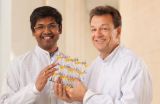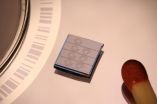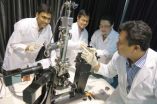(Press-News.org) Changes at the atom level in nanowires offer vast possibilities for improvement of solar cells and LED light. NTNU-researchers have discovered that by tuning a small strain on single nanowires they can become more effective in LEDs and solar cells.
NTNU researchers Dheeraj Dasa and Helge Weman have, in cooperation with IBM, discovered that gallium arsenide can be tuned with a small strain to function efficiently as a single light-emitting diode or a photodetector. This is facilitated by the special hexagonal crystal structure, referred to as wurtzite, which the NTNU researchers have succeeded in growing in the MBE lab at NTNU. The results were published in Nature Communications this week.
The last few years have seen significant breakthroughs in nanowire and graphene research at NTNU. In 2010, Professors Helge Weman, Bjørn-Ove Fimland and Ton van Helvoort and their academic group went public with their first groundbreaking discoveries within the field.
The researchers, who specialise on growing nanowires, had succeeded in controlling a change in the crystal structure during nanowire growth. By altering the crystal structure in a substance, i.e. changing the positions of the atoms, the substance can gain entirely new properties. The NTNU researchers discovered how to alter the crystal structure in nanowires made of gallium arsenide and other semiconductors.
With that, the foundation was laid for more efficient solar cells and LEDs.
– Our discovery was that we could manipulate the structure, atom by atom. We were able to manipulate the atoms and alter the crystal structure during the growth of the nanowires. This opened up for vast new possibilities. We were among the first in the world who were able to create a new gallium arsenide material with a different crystal structure, says Helge Weman at the Department of Electronics and Telecommunications.
This process exists in nature as well. For example, diamond and graphite – the latter is used as the "lead" in pencils – are composed by the same carbon atoms. But their crystal structures are different.
And now, researchers can also change the structure of nanowires at the atom level.
Graphene, the super-material
The next big news came in 2012. At that point, the researchers had managed to make semiconductor nanowires grow on the super-material graphene. Graphene is the thinnest and strongest material ever made. This discovery was described as a revolution in solar cell and LED component development.
Over time, graphene can replace silicon as a component in electronic circuits. Today, silicon is used for producing both electronics and solar cells. Graphene conducts electricity 100 times faster than silicon, and is only one atom thick, while a silicon wafer is normally millions of times thicker. Graphene will also likely be cheaper than silicon in just a few years.
The research group has received a lot of international attention for the graphene method. Helge Weman and his NTNU co-founders Bjørn-Ove Fimland and Dong-Chul Kim have established the company CrayoNano AS, working with a patented invention that grows semiconductor nanowires on graphene. The method is called molecular beam epitaxy (MBE), and the hybrid material has good electric and optical properties.
– We are showing how to use graphene to make much more effective and flexible electronic products, initially solar cells and white light-emitting diodes (LED). The future holds much more advanced applications, says Weman.
Highly effective solar cells
– Our goal is to create solar cells that are more effective than when they are made with thin film technology, Weman emphasises.
Thin film technology is a term from the solar cell technology. This technology develops super-thin solar cell panels, where the active layer converting sunlight to electricity has a thickness of no more than three micrometres, i.e. three thousands of a millimetre. The low weight allows easy transportation, installation and maintenance of the solar cells, and they can in practice be rolled out like roofing felt on most buildings.
Now, the combination of nanowires and graphene facilitates much broader and more flexible solar cells.
In thin films like gallium arsenide, the atoms are placed cubically in a fixed, predefined structure. When the researchers manipulate the atom structure inside the nanowire, they can grow both cubic and hexagonal crystal structures. The different structures have completely different properties, for example when it comes to optical properties.
New discoveries, new possibilities
The last couple of years the research group has, among other things, studied the unique hexagonal crystal structure in the GaAs nanowires.
– In cooperation with IBM, we have now discovered that if we stretch these nanowires, they function quite well as light-emitting diodes. Also, if we press the nanowires, they work quite well as photodetectors. This is facilitated by the hexagonal crystal structure, called wurtzite. It makes it easier for us to change the structure to optimise the optical effect for different applications.
– It also gives us a much better understanding, allowing us to design the nanowires with a built-in compressive stress, for example to make them more effective in a solar cell. This can for instance be used to develop different pressure sensors, or to harvest electric energy when the nanowires are bent, Weman explains.
Because of this new ability to manipulate the nanowires' crystal structure, it is possible to create highly effective solar cells that produce a higher electric power. Also, the fact that CrayoNano now can grow nanowires on super-light, strong and flexible graphene, allows production of very flexible and lightweight solar cells.
The CrayoNano group will now also start growing gallium nitride nanowires for use in white light-emitting diodes.
– One of our objectives is to create gallium nitride nanowires in a newly installed MBE machine at NTNU to create light-emitting diodes with better optical properties – and grow them on graphene to make them flexible, lightweight and strong.
INFORMATION: END
Better solar cells, better LED light and vast optical possibilities
Progress in the small
2014-04-14
ELSE PRESS RELEASES FROM THIS DATE:
Pioneering findings on the dual role of carbon dioxide in photosynthesis
2014-04-14
Scientists at Umeå University in Sweden have found that carbon dioxide, in its ionic form bicarbonate, has a regulating function in the splitting of water in photosynthesis. This means that carbon dioxide has an additional role to being reduced to sugar. The pioneering work is published in the latest issue of the scientific journal PNAS.
It is well known that inorganic carbon in the form of carbon dioxide, CO2, is reduced in a light driven process known as photosynthesis to organic compounds in the chloroplasts. Less well known is that inorganic carbon also affects the ...
The result of slow degradation
2014-04-14
This news release is available in German. Although persistent environmental pollutants have been and continue to be released worldwide, the Arctic and Antarctic regions are significantly more contaminated than elsewhere. The marine animals living there have some of the highest levels of persistent organic pollutant (POP) contamination of any creatures. The Inuit people of the Arctic, who rely on a diet of fish, seals and whales, have also been shown to have higher POP concentrations than people living in our latitudes.
Today, the production and use of nearly two dozen ...
Nutrient-rich forests absorb more carbon
2014-04-14
The ability of forests to sequester carbon from the atmosphere depends on nutrients available in the forest soils, shows new research from an international team of researchers including the International Institute for Applied Systems Analysis (IIASA).
The study showed that forests growing in fertile soils with ample nutrients are able to sequester about 30% of the carbon that they take up during photosynthesis. In contrast, forests growing in nutrient-poor soils may retain only 6% of that carbon. The rest is returned to the atmosphere as respiration.
"This paper produces ...
Scientists open door to better solar cells, superconductors and hard-drives
2014-04-14
Using DESY's bright research light sources, scientists have opened a new door to better solar cells, novel superconductors and smaller hard-drives. The research reported in the scientific journal Nature Communications this week enhances the understanding of the interface of two materials, where completely new properties can arise. With their work, the team of Prof. Andrivo Rusydi from the National University of Singapore and Prof. Michael Rübhausen from the Hamburg Center for Free-Electron Laser Science (CFEL) have solved a long standing mystery in the physics of condensed ...
Combs of light accelerate communication
2014-04-14
This news release is available in German.
Miniaturized optical frequency comb sources allow for transmission of data streams of several terabits per second over hundreds of kilometers – this has now been demonstrated by researchers of Karlsruhe Institute of Technology (KIT) and the Swiss École Polytechnique Fédérale de Lausanne (EPFL) in a experiment presented in the journal Nature Photonics. The results may contribute to accelerating data transmission in large computing centers and worldwide communication networks. (DOI: 10.1038/NPHOTON.2014.57.)
The amount of ...
Proteomics International biomarker study closer to a CDx test for diabetic kidney disease
2014-04-14
April 2014, Perth, Australia. Drug discovery company Proteomics International has completed an important milestone towards the development of a companion diagnostic (CDx) test with the validation of several of its protein biomarkers.
The research team authenticated the panel of biomarkers after taking 508 highly curated disease and control samples. Seven biomarkers were validated at high stringency using the company's proprietary mass spectrometry approach.
The mass spectrometry data was then cross-validated using immunoassays in collaboration with the KTH Royal Institute ...
Beneficial organisms react differently to parasite drug
2014-04-14
The substance ivermectin has been used for more than thirty years all over the world to combat parasites like roundworms, lice and mites in humans, livestock and pets. The active ingredient belongs to the chemical group of avermectins, which generally disrupt cell transport and thus attack pests. When ivermectin is excreted in the faeces of treated animals, at overly high doses it also harms dung-degrading beneficial insects like dung beetles and dung flies. This impairs the functioning of the ecosystem. In extreme cases the dung is not decomposed and the pasture is destroyed.
Sensitivity ...
Does germ plasm accelerate evolution?
2014-04-14
Scientists at The University of Nottingham have published research in the leading academic journal Science that challenges a long held belief about the way certain species of vertebrates evolved.
Dr Matt Loose and Dr Andrew Johnson who are experts in genetics and cell development in the School of Life Sciences carried out the research, funded by the Medical Research Council (MRC). It suggests that genes evolve more rapidly in species containing germ plasm. The results came about as they put to the test a novel theory that early developmental events dramatically alter ...
Novel technique developed by NUS scientists opens door to better solar cells
2014-04-14
A team of scientists, led by Assistant Professor Andrivo Rusydi from the Department of Physics at the National University of Singapore's (NUS) Faculty of Science, has successfully developed a technique to study the interface between materials, shedding light on the new properties that arise when two materials are put together.
With a better understanding of how materials interface, scientists can tweak the properties of different materials more easily, and this opens doors to the development of better solar cells, novel superconductors and smaller hard drives.
The ...
Stanford team develops single cell genomics technique to reverse engineer developing lung
2014-04-14
Consider the marvel of the embryo. It begins as a glob of identical cells that change shape and function as they multiply to become the cells of our lungs, muscles, nerves and all the other specialized tissues of the body.
Now, in a feat of reverse tissue engineering, Stanford researchers have begun to unravel the complex genetic coding that allows embryonic cells to proliferate and transform into all of the specialized cells that perform a myriad of different biological tasks.
A team of interdisciplinary researchers took lung cells from the embryos of mice, choosing ...
LAST 30 PRESS RELEASES:
UVA’s Jundong Li wins ICDM’S 2025 Tao Li Award for data mining, machine learning
UVA’s low-power, high-performance computer power player Mircea Stan earns National Academy of Inventors fellowship
Not playing by the rules: USU researcher explores filamentous algae dynamics in rivers
Do our body clocks influence our risk of dementia?
Anthropologists offer new evidence of bipedalism in long-debated fossil discovery
Safer receipt paper from wood
Dosage-sensitive genes suggest no whole-genome duplications in ancestral angiosperm
First ancient human herpesvirus genomes document their deep history with humans
Why Some Bacteria Survive Antibiotics and How to Stop Them - New study reveals that bacteria can survive antibiotic treatment through two fundamentally different “shutdown modes”
UCLA study links scar healing to dangerous placenta condition
CHANGE-seq-BE finds off-target changes in the genome from base editors
The Journal of Nuclear Medicine Ahead-of-Print Tip Sheet: January 2, 2026
Delayed or absent first dose of measles, mumps, and rubella vaccination
Trends in US preterm birth rates by household income and race and ethnicity
Study identifies potential biomarker linked to progression and brain inflammation in multiple sclerosis
Many mothers in Norway do not show up for postnatal check-ups
Researchers want to find out why quick clay is so unstable
Superradiant spins show teamwork at the quantum scale
Cleveland Clinic Research links tumor bacteria to immunotherapy resistance in head and neck cancer
First Editorial of 2026: Resisting AI slop
Joint ground- and space-based observations reveal Saturn-mass rogue planet
Inheritable genetic variant offers protection against blood cancer risk and progression
Pigs settled Pacific islands alongside early human voyagers
A Coral reef’s daily pulse reshapes microbes in surrounding waters
EAST Tokamak experiments exceed plasma density limit, offering new approach to fusion ignition
Groundbreaking discovery reveals Africa’s oldest cremation pyre and complex ritual practices
First breathing ‘lung-on-chip’ developed using genetically identical cells
How people moved pigs across the Pacific
Interaction of climate change and human activity and its impact on plant diversity in Qinghai-Tibet plateau
From addressing uncertainty to national strategy: an interpretation of Professor Lim Siong Guan’s views
[Press-News.org] Better solar cells, better LED light and vast optical possibilitiesProgress in the small



